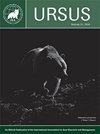Behavior of the European brown bear at rub trees
IF 0.6
4区 生物学
Q4 ZOOLOGY
引用次数: 4
Abstract
Abstract: The rubbing of trees by bears is an example of scent-marking that has been studied only in a limited number of bear species in the world. Our study analyzes the marking behavior of the European brown bear (Ursus arctos), based on filming by remote cameras placed in front of 25 rub trees in the central Italian Alps during 2012 to 2014. We obtained 546 videos of bears from a sampling effort of 9,302 camera-days. The bears captured in the videos were classified according to age and sex, and type and duration of each behavior was recorded. The data allowed us to assess temporal patterns of rubbing behavior and differences within sex, age, and among individuals. Rubbing was performed significantly more by adult males, with a peak during the breeding season. Adult males also used a variety of positions to mark the trees as compared with the other sex–age classes. Rubbing also was observed during the nonbreeding season, but with lower frequency, whereas investigation of rub trees was performed by bears of all ages and sexes throughout the seasons. The only 3 female bears that rubbed the trees were recorded in autumn, outside the breeding season. The results showed that scent-marking triggered a response in individuals that subsequently passed by the same rub tree; in 62% of the cases, the second bear either rubbed or investigated the tree, regardless of the time since the passage of the first bear. Our results supported the hypothesis that tree-rubbing during the breeding season is a means of communication, as already documented for brown bears and American black bears (U. americanus) in North America, but the function of this display outside the breeding season remains unclear.欧洲棕熊在摩擦树上的行为
摘要:熊对树木的摩擦是一种气味标记,目前只在世界上有限的熊类中进行了研究。我们的研究分析了欧洲棕熊(Ursus arctos)的标记行为,基于2012年至2014年在意大利阿尔卑斯山中部25棵橡胶树前放置的远程摄像机的拍摄。我们从9302个摄像机日的采样工作中获得了546个熊的视频。视频中捕捉到的熊根据年龄和性别进行了分类,并记录了每种行为的类型和持续时间。这些数据使我们能够评估摩擦行为的时间模式,以及性别、年龄和个体之间的差异。成年雄蚊的摩擦行为明显增多,在繁殖季节达到高峰。成年雄性也用不同的位置来标记树木,以与其他性别年龄阶层进行比较。在非繁殖季节也观察到摩擦,但频率较低,而在整个季节,所有年龄和性别的熊都对摩擦树进行了调查。仅有的3只雌熊在秋天蹭树的记录是在繁殖季节之外。结果表明,气味标记在随后经过同一棵搓树的个体中引发了反应;在62%的情况下,第二只熊要么摩擦树,要么调查树,而不管第一只熊经过的时间。我们的研究结果支持了一种假设,即在繁殖季节摩擦树木是一种交流手段,正如已经记录的北美棕熊和美国黑熊(美国黑熊)一样,但这种表现在繁殖季节之外的功能尚不清楚。
本文章由计算机程序翻译,如有差异,请以英文原文为准。
求助全文
约1分钟内获得全文
求助全文
来源期刊

Ursus
生物-动物学
CiteScore
2.00
自引率
15.40%
发文量
12
审稿时长
>12 weeks
期刊介绍:
Ursus includes a variety of articles on all aspects of bear management and research worldwide. Original manuscripts are welcome. In addition to manuscripts reporting original research, submissions may be based on thoughtful review and synthesis of previously-reported information, innovative philosophies and opinions, and public policy or legal aspects of wildlife conservation. Notes of general interest are also welcome. Invited manuscripts will be clearly identified, but will still be subject to peer review. All manuscripts must be in English. All manuscripts are peer-reviewed, and subject to rigorous editorial standards.
 求助内容:
求助内容: 应助结果提醒方式:
应助结果提醒方式:


